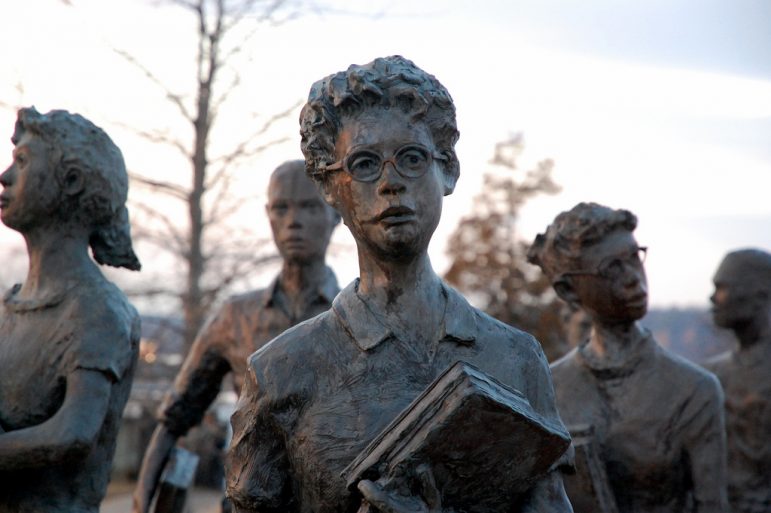It’s Wednesday morning at Birmingham’s Central Park Elementary and the third graders are learning about descriptive writing. The kids work diligently on their stories, sharing them anxiously with their classmates.
The teacher has written a list of descriptive words on the chalkboard. All around the room, brightly-colored education posters encourage kids to study, to eat well, to follow the rules. But look closer and the room shows its age. The tiles on the floor are cracked and there aren’t any computers, except the teachers. There’s one other thing you notice. Every student is black. Every single one! No white students, no Asians, no latinos. 50 years after Brown-versus-Board of Education TWO, many urban schools like Central Park Elementary are again segregated. U.S. Congressman Artur Davis remembers giving a Martin Luther King Day speech at a local high school.
“I got to the point in the speech where I was beginning to talk about King’s belief in integration and his belief in one community, and it occurred to me as I was saying that in this public school in a racially mixed city, there was not a single white student in the auditorium.”
“The segregation that we see now is different.”
Michael Froning has been a classroom teacher for more than three decades. He’s currently dean of the University of Alabama at Birmingham School of Education.
“In the old days African American students could not go to schools that were predominately white – by law – now those same schools are still segregated, but they’re segregated more by out choices of where we live, whom we want to live with.”
And that’s a tougher nut to crack, observers say, because you can’t legislate where people can live. In the 1970’s, Birmingham’s white residents started moving en masse to the suburbs. Very quickly those school districts started outpacing Birmingham on standardized test scores and graduation rates. Ronald Jackson took notice and started a group called Citizens for Better Schools, which has watched in frustration as Birmingham City Schools have re-segregated. In 1984, the district achieved “unitary status”, meaning it had satisfied the court order to desegregate, but today, the student population of Birmingham city schools is 95% African American. And, says Ronald Jackson, there’s another troubling trend.
“You have black middle class flight from Birmingham city schools. So we have this double barrel effect that we believe is the vestage of Jim Crow segregation in our schools.”
As more black professionals leave the urban core, in search of better schools for their own kids, the city’s tax base goes down and there’s less money for public education. It’s a vicious cycle, says Lawrence Pijeaux, Director of the Birmingham Civil Rights Institute, and it’s not going to change until whites and upwardly mobile blacks recognize it’s a problem for everyone — not just the nation’s urban core.
“For youngsters who find themselves in school districts that may have limited resources you reduce the probability of those young people reaching their full potential. And if we don?t have all of our young people reaching their potential then we find ourselves years later supporting all those young people.”
Again, Congressman Artur Davis.
“As the schools have become re-segregated you’re seeing a greater funding gap than ever between predominately black systems and predominately white systems and you’re increasingly seeing a lack of willingness in the white community to vote for tax increases that they fear would affect schools that don’t serve their children.”
Congressman Davis says he hears a lot from his constituents about wanting quality schools, but surprisingly little about wanting more integrated education. It begs the question, 50 years post-Brown versus Board — is full integration still a worthy and desirable goal? Or are “separate but equal” schools okay?”
Horace Huntley teaches African American history at the University of Alabama at Birmingham.
“We have internalized this whole concept that black children, in order to learn, they must sit next to white children. Let’s not tell me that my child cannot learn if he’s not sitting next to a child of another race.”
Ronald Jackson, of Citizens for Better Schools, agrees that academically black and white kids do just fine separated, but socially and culturally, he says, there’s merit to integration. Jackson predicts a growing movement against re-segregation — with non-violent protests and perhaps even litigation.
“We must remind the federal judiciary that they have a solemn obligation to enforce the edicts of brown versus board of education and where they have sat over the last 25 years and not mandated that these local school districts comply with the law, then they are in dereliction of their oaths.”
“There’s no law that congress or the Alabama legislature could pass tomorrow that could integrate schools single handedly.”
Again, Congressman Artur Davis.
“I suppose you could get a set of courts that 20 years from now or 10 years now might say we might bus people, move people around to achieve integration. But if you haven’t built a political foundation for integration, those courts would be ignored or people would find some way around their commands.”
Ultimately, the success of desegregation lies in the hearts of people and the ability of politicians and activists to convince them they have a stake in the fortunes of people who aren?t like them economically or racially.

